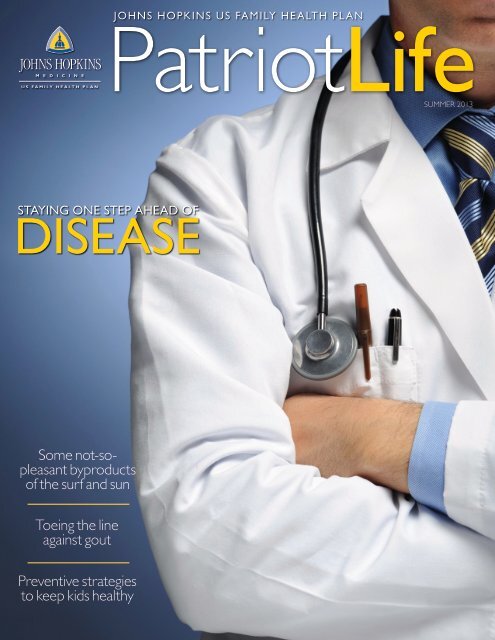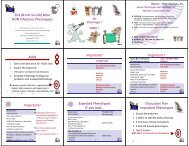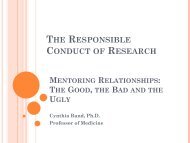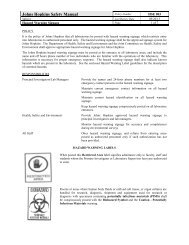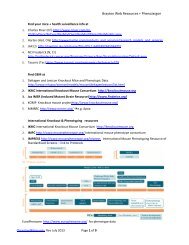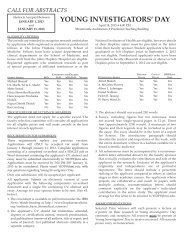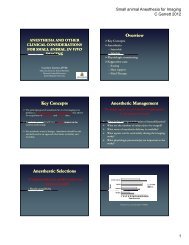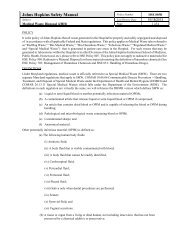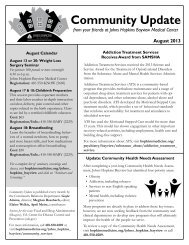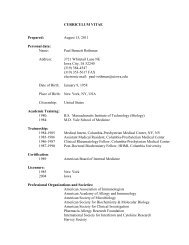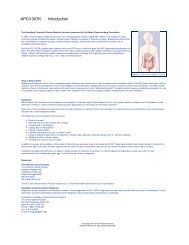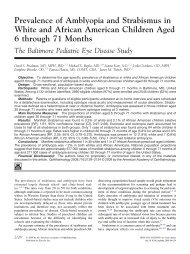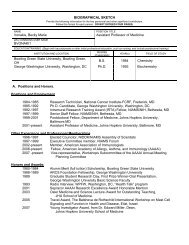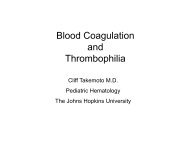DISEASE - Johns Hopkins Medical Institutions
DISEASE - Johns Hopkins Medical Institutions
DISEASE - Johns Hopkins Medical Institutions
Create successful ePaper yourself
Turn your PDF publications into a flip-book with our unique Google optimized e-Paper software.
JOHNS HOPKINS US FAMILY HEALTH PLAN<br />
PatriotLife<br />
SUMMER 2013<br />
STAYING ONE STEP AHEAD OF<br />
<strong>DISEASE</strong><br />
Some not-sopleasant<br />
byproducts<br />
of the surf and sun<br />
Toeing the line<br />
against gout<br />
Preventive strategies<br />
to keep kids healthy
TO YOUR HEALTH<br />
Not So Fun<br />
Some not-so-pleasant byproducts of the surf and sun.<br />
SWIMMER’S EAR: Develops when excess water, sand or dirt enter the ear<br />
canal, causing inflammation and infection. Symptoms include itching, fullness in<br />
the ear, temporarily muffled hearing and pain.<br />
Treatment: Ease ear pain by applying a warm washcloth. Gently rinse the<br />
ear using a bulb syringe and warm saline solution or a half-and-half solution<br />
of white vinegar and warm water. Contact your doctor if the ear becomes<br />
red, swollen or very painful; dizziness or bleeding/discharge from the ear<br />
develops; or ear symptoms worsen or last longer than a week.<br />
SUNBURN: Caused by the sun’s ultraviolet rays. Most sunburns prompt mild<br />
pain and redness, affecting the outer layer of skin. If skin swells up and blisters,<br />
it could mean that deep skin layers and nerve endings have been damaged.<br />
Treatment: Bathe in lukewarm water or apply cold compresses to the affected<br />
area. Apply aloe or moisturizing lotion. Take pain relievers. Replace<br />
body fluids with water, juice or sports drinks. Call a health care provider<br />
if sunburn occurs in children under age one, fever develops, blisters show<br />
signs of infection, or symptoms become more severe or frequent. To prevent<br />
sunburn, avoid the midday sun (10 am to 4 pm); if you must be outdoors,<br />
wear a wide-brimmed hat and protective clothing, and use plenty<br />
of sunscreen.<br />
For more information visit www.hopkinsmedicine.org/usfhp and click the<br />
button titled A-Z Healthwise.<br />
PUSH BACK AGAINST PULLED MUSCLES<br />
While a pulled muscle can temporarily sideline you, there are easy steps you can take<br />
(and some to avoid) to get back in the game. Here are some treatment dos and don’ts<br />
from the experts in Orthopedic Surgery at <strong>Johns</strong> <strong>Hopkins</strong> Medicine. For more information,<br />
visit http://www.hopkinsortho.org/muscle_strain.html.<br />
DON’T:<br />
• Apply heat too soon. In the first 24 to 48 hours, heat can actually increase swelling.<br />
• Massage too vigorously. Done incorrectly, a massage could exacerbate your injury.<br />
• Return to activity too soon. A damaged muscle is more vulnerable to a worse<br />
injury.<br />
DO:<br />
• Apply ice. It’s best to ice your injured muscle for about 20 minutes, two to three<br />
times daily.<br />
• Take anti-inflammatory medication, such Tylenol, Motrin or Aleve upon direction<br />
from your physician.<br />
• Rest—but not for too long. As soon as you physically can, gradually begin moving<br />
the joints and muscle to prevent stiffness, atrophy and weakness. When you’re<br />
ready, try some light stretching and movement.<br />
• Seek help from a physical therapist or orthopedist, especially for more severe<br />
strains.<br />
Resume regular activities when you can fully move without pain and your strength equals<br />
that of your uninjured side. And don’t forget: Always warm up before stretching to prevent<br />
further injury.<br />
2 • PatriotLife • SUMMER 2013 www.hopkinsmedicine.org/usfhp
Toeing the Line<br />
Against Gout<br />
Wondering what King Henry VIII,<br />
Dick Cheney and Luciano Pavarotti<br />
all have in common?<br />
They’ve all had gout.<br />
A common form of inflammatory arthritis,<br />
gout occurs when excessive uric acid crystals<br />
are deposited into connective tissues and<br />
joints, causing swelling, stiffness, pain, heat<br />
and redness. Once considered a disease fit for<br />
kings—because of its association with overindulging<br />
in food and drink—today gout is no<br />
longer reserved for the well-to-do.<br />
“Today, the demographic can include<br />
people who are overweight, eat foods high<br />
in purine—such as organ meat, sardines or<br />
beer—and have medical conditions like hypertension,<br />
which is a risk factor for gout,”<br />
says Sabiha Khan, M.D., a rheumatologist with<br />
<strong>Johns</strong> <strong>Hopkins</strong> Community Physicians Downtown<br />
Bethesda.<br />
Gout is most commonly seen in men in<br />
their 30s and 40s and women in their 60s.<br />
It can affect any joint, but is most common<br />
in the big toe. “Usually only one joint is affected,”<br />
Khan says, “but it can also affect multiple<br />
joints at once.” Individuals who struggle<br />
with obesity, hypertension or joint trauma<br />
may be particularly at risk, as are those who<br />
use diuretic medications or have family history<br />
of gout.<br />
The condition can cause a fiery pain that<br />
will wake you in the middle of the night and<br />
render the slightest movement unbearable.<br />
Recurrent attacks can cause long-term joint<br />
damage to the joint and high levels of uric acid<br />
can lead to kidney stones.<br />
Gout is treatable. Medications usually include<br />
non-steroidal anti-inflammatory drugs<br />
(NSAIDS), corticosteroids and medications<br />
to block or better process uric acid. Sufferers<br />
should avoid foods that can serve as “triggers,”<br />
including shellfish, beer, hard alcohol<br />
and foods flavored with high fructose corn<br />
syrup.<br />
“While medications can play a big role in<br />
treating gout,” Khan says, “dietary changes<br />
and weight loss can also really help.”<br />
If you are experiencing any symptoms<br />
please contact your primary care physician.<br />
www.hopkinsmedicine.org/usfhp<br />
PatriotLife • SUMMER 2013 • 3
COVER STORY<br />
STAYING<br />
ONE STEP<br />
AHEAD OF<br />
<strong>DISEASE</strong><br />
Even with weight loss programs like the<br />
Paleo Diet and the South Beach Diet<br />
bolstering a billion-dollar diet industry,<br />
chronic disease remains the leading cause<br />
of death and disability across the United<br />
States.<br />
Indeed, 75 percent of the money spent on health<br />
care goes to the treatment of chronic diseases like<br />
Type 2 diabetes and congestive heart failure. And<br />
yet these illnesses are also highly preventable. Of<br />
course, diet and exercise alone can go far in avoiding<br />
a lifetime of poor health. But if you want to<br />
stay a step ahead of disease, your doctor should be<br />
a primary partner, and preventive screenings and<br />
care should be considered mandatory steps in your<br />
pursuit of good health.<br />
“If you don’t go to the doctor, there may be no<br />
one telling you to change the bad habits,” says Alice<br />
Lee, M.D., an internal medicine specialist with<br />
<strong>Johns</strong> <strong>Hopkins</strong> Community Physicians at White<br />
Marsh. “It’s a lot easier to be unhealthy if you don’t<br />
go to the doctor, because you’re basically putting<br />
your head in the sand.”<br />
Perhaps the simplest step toward disease prevention<br />
is a regularly scheduled physical exam. Considered<br />
a staple of preventive medicine, a physical<br />
generally consists of a doctor taking your medical<br />
history, checking your blood pressure, weight, and<br />
other vital signs, examining your body (head, neck,<br />
skin, extremities, etc.) and possibly conducting a<br />
battery of lab tests. While much of the exam focuses<br />
on assessing your current health, your physician<br />
should also screen for disease risk.<br />
4 • PatriotLife • SUMMER 2013 www.hopkinsmedicine.org/usfhp
“If someone comes in for a physical, we always<br />
talk about their history and what kinds of risks they<br />
might have and advise them accordingly,” Lee says.<br />
“If they have a family history of heart disease, we’re<br />
going to be even more likely to recommend a healthier<br />
diet and regular exercise and to encourage them<br />
to monitor their cholesterol and<br />
WHEN IT COMES TO AGE, there’s your chronological<br />
age and there’s your biological, or health age—and<br />
the two don’t always line up.<br />
Determined by issues like weight, disease history, diet<br />
and exercise habits, health age measures the degree<br />
of aging your body has experienced versus how old<br />
you actually are. A healthy-eating 45-year-old aerobics<br />
instructor with no history of chronic illness might have a<br />
health age of 37. Conversely, a 45-year-old smoker who<br />
is overweight might have a biological age of 62.<br />
In this age of obesity and chronic disease, “we see a<br />
lot of people who are older than their actual ages,” says<br />
Wendy Bowen, a health coach with USFHP. “We deal<br />
with a lot of chronic diseases and obesity, and those<br />
patients will be older because of their conditions.”<br />
Smoking, a high-fat diet and a sedentary lifestyle all<br />
increase your disease risk, and likewise, your health age.<br />
The good news? While chronological age moves<br />
relentlessly onward, your health age is less constant. If<br />
you give up your regular trips to McDonald’s or kick the<br />
smoking habit, time can be turned back.<br />
“IF YOU DON’T GO<br />
TO THE DOCTOR,<br />
THERE MAY BE NO<br />
ONE TELLING YOU<br />
TO CHANGE THE<br />
BAD HABITS.”<br />
—ALICE LEE<br />
blood pressure.”<br />
Of course, while some preventive<br />
measures are applicable to<br />
everyone, gender and age can also<br />
play a role. At age 50, for instance,<br />
both men and women should begin<br />
to get screened for colon cancer.<br />
Women ages 18 to 65 should have<br />
a pap smear every three years<br />
(after three consecutive normal tests), while mammograms<br />
are advised annually for women starting<br />
at age 39 (and earlier for those at high risk). Prostate<br />
cancer screening for men is more controversial and<br />
should be discussed with the primary care physician.<br />
Men between 65 and 75 who smoke should have an<br />
ultrasound to screen for abdominal aortic aneurysm.<br />
“The kinds of screenings we recommend are highly<br />
dependent on the age and gender of the person,”<br />
Lee explains. “There’s a big difference in what I’d<br />
recommend to someone who is 22 years old, versus<br />
73 years old.”<br />
She notes that it’s crucial to utilize screening tests<br />
well before symptoms occur. “Once you have symptoms,<br />
that’s not a screening anymore,”<br />
she says. “The idea is to get tested for<br />
something before symptoms appear<br />
so that you can be treated and remain<br />
healthier.” Further, she says, no test or<br />
screening can substitute for a healthy,<br />
active lifestyle of nutritious eating and<br />
regular exercise.<br />
“Diet and exercise are, of course,<br />
good preventive measures, and<br />
they’re also the treatment measures we use to reverse<br />
chronic illnesses,” she says. “We often have<br />
patients who say, ‘My father died at age 57. I want<br />
to be there for my children and grandchildren. What<br />
can I do to live longer?”<br />
To find out screening recommendations, visit the<br />
links under Adult Health at: www.hopkinsmedicine.<br />
org/usfhp/members_visitors/health_education/library.<br />
html.<br />
*<br />
How Old Are You, Really?<br />
“People can change their lives so that they’re eating<br />
healthier and exercising regularly,” says Bowen. “We’ve<br />
seen diabetics lower their blood glucose levels and<br />
people with high blood pressure decrease their need<br />
for medication—all by making changes and developing a<br />
healthy lifestyle.” You can start making small changes so<br />
that, eventually, you<br />
are the health age<br />
you’re supposed to<br />
be, or even younger.<br />
To find out more<br />
about USFHP’s<br />
health education<br />
programs, or connect<br />
for free with a health<br />
coach, visit: www.<br />
hopkinsmedicine.org/<br />
usfhp/members_visitors/health_education/<br />
www.hopkinsmedicine.org/usfhp<br />
PatriotLife • SUMMER 2013 • 5
BRIEFING ROOM<br />
Connect with MyChart<br />
<strong>Johns</strong> <strong>Hopkins</strong> Medicine is pleased to now offer<br />
a convenient, secure and free way for people<br />
to connect with their health information and<br />
health care team—anytime and anywhere.<br />
Through a secure website, called <strong>Johns</strong> <strong>Hopkins</strong><br />
Medicine MyChart, patients seen through <strong>Johns</strong><br />
<strong>Hopkins</strong> Community Physicians (JHCP) can<br />
access portions of their medical record, send<br />
messages to their health care team, renew<br />
prescriptions, request appointments and more.<br />
For more information, visit https://mychart.<br />
hopkinsmedicine.org.<br />
Saturday Hours<br />
Preventive Strategies<br />
to Keep Kids Healthy<br />
While back-to-school days may seem way<br />
off, summer is the perfect time to make<br />
sure your children are up-to-date on their<br />
immunizations and screening tests.<br />
Immunizations: Before their second<br />
birthdays, children are required to<br />
receive a broad array of immunizations<br />
(to prevent everything from<br />
measles and rubella to mumps<br />
and chicken pox). Between ages<br />
10 to 13 they must get additional<br />
immunizations (including<br />
tetanus, diphtheria, meningococcal).<br />
Annual well-child visits with<br />
your pediatrician will ensure your<br />
kids have the vaccinations they<br />
need to stay healthy and prevent<br />
the spread of serious illness to their<br />
classmates.<br />
Screenings: Lead screening tests are<br />
recommended for babies ages 12 to<br />
23 months. Consult with your physician<br />
about this and other screening tests,<br />
including a blood test to screen for cholesterol.<br />
(The fatty build-up of plaque in<br />
the arteries begins in childhood and progresses<br />
into adulthood, often leading to<br />
coronary heart disease).<br />
For more information, visit Vaccinations<br />
and Immunizations at http://<br />
www.hopkinsmedicine.org/usfhp/<br />
members_visitors/health_education/<br />
library.html<br />
<strong>Johns</strong> <strong>Hopkins</strong> Community Physicians practices at Odenton, Canton Crossing and<br />
North Bethesda are open on Saturdays from 9 a.m. to 1 p.m. for appointments. To<br />
make an appointment, please call 410-874-1400 for Odenton, 410-522-9940 for<br />
Canton Crossing, and 240-314-7080 for North Bethesda.<br />
6 • PatriotLife • SUMMER 2013 www.hopkinsmedicine.org/usfhp
Notification of Material Changes<br />
to Notice of Privacy Practice<br />
We have modified our Notice of Privacy Practices to better inform<br />
you of how health information about you may be used<br />
or disclosed by us and what rights you have with respect to<br />
your health information maintained by us. Below is a summary<br />
of those material changes.<br />
Fund-raising activities. We may contact you to provide information about<br />
Plan-sponsored activities, including fund-raising programs and events to support<br />
research, teaching or plan member care. In addition to using your contact information,<br />
such as your name, address, phone, and dates of service provided to you, we<br />
may now use the hospital or clinic department where you were seen, the name of<br />
the physician you saw, the outcome of your treatment, and your health insurance<br />
status for such fund-raising purposes. If we do contact you for fund-raising activities,<br />
the communication you receive will have instructions on how you may ask for<br />
us not to contact you again for such purposes, also known as an “opt-out.”<br />
Genetic information. As of September 23, 2013, the Plan may not use or disclose<br />
any genetic information about you for underwriting purposes.<br />
Other uses of health information. We may not use or disclose your health<br />
information for those purposes not covered by the Notice of Privacy Practices<br />
without first obtaining your written authorization (permission). Most uses and<br />
disclosures of your health information for marketing purposes fall within this category<br />
and require your authorization (permission) before we may use your health<br />
information for these purposes. Additionally, with certain limited exceptions, as<br />
of September 23, 2013, we are not allowed to sell or receive anything of value in<br />
exchange for your health information without your written authorization (permission).<br />
Right to be notified in the event of a breach. You have the right to be notified<br />
if your health information has been “breached,” which means that your health<br />
information has been used or disclosed in a way that is<br />
inconsistent with law and results in it being compromised.<br />
A copy of the <strong>Johns</strong> <strong>Hopkins</strong> US Family Health Plan’s NPP may be obtained by<br />
calling Customer Service at 1-800-808-7347 or may be accessed on our web site<br />
at www.hopkinsmedicine.org/usfhp<br />
www.hopkinsmedicine.org/usfhp<br />
PatriotLife • SUMMER 2013 • 7
PatriotLife<br />
Patriot Life, the official newsletter of the <strong>Johns</strong> <strong>Hopkins</strong> US<br />
Family Health Plan (USFHP), is published quarterly by <strong>Johns</strong><br />
<strong>Hopkins</strong> Medicine Marketing and Communications. For more<br />
information, call 800-808-7347.<br />
Mary Cooke, Vice President, USFHP<br />
Melissa Teves, Senior Director, Administration, USFHP<br />
Keith Langrehr, Marketing Director, USFHP<br />
Susan Fratto, Marketing Manager, USFHP<br />
Sue De Pasquale, Editor<br />
Lauren Manfuso, Writer<br />
Jason Teves, Designer, USFHP Project Manager<br />
<strong>Johns</strong> <strong>Hopkins</strong> Medicine<br />
US Family Health Plan<br />
6704 Curtis Court<br />
Glen Burnie, MD 21060<br />
NonProfit Org.<br />
U.S. Postage<br />
PAID<br />
Abingdon, MD<br />
Permit No. 391<br />
www.hopkinsmedicine.org/usfhp<br />
© 2013 The <strong>Johns</strong> <strong>Hopkins</strong> University and<br />
The <strong>Johns</strong> <strong>Hopkins</strong> Health System Corporation<br />
<strong>Johns</strong> <strong>Hopkins</strong> US<br />
Family Health Plan<br />
We’re in Your<br />
Neighborhood<br />
The <strong>Johns</strong> <strong>Hopkins</strong> US Family Health<br />
Plan has more than 110 primary<br />
care offices to serve our members,<br />
including 2 new locations (yellow<br />
bullets). One in Washington, D.C. and<br />
the other in Fulton, Maryland.<br />
Need the most upto-date<br />
listing?<br />
Visit hopkinsmedicine.org/usfhp and<br />
click Members & Visitors, then Locations.<br />
8 • PatriotLife • SUMMER 2013 www.hopkinsmedicine.org/usfhp


